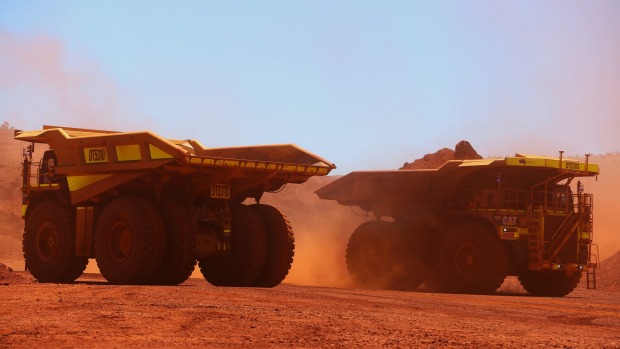The world’s second largest iron ore exporter, Brazilian miner Vale, is set to establish a strategic foothold in Australia’s iron ore heartland if a memorandum of understanding with Fortescue Metals Group is formalised.
Vale could buy up to 15 per cent of Fortescue shares and a direct stake in the Australian company’s mines under the terms of the shock announcement, which looms as the biggest corporate manoeuvre in the Pilbara since BHP and Rio Tinto considered merging their iron ore divisions in 2010.
Fortescue and Vale are also investigating whether to create an iron ore joint venture, which would see them blend Australian and Brazilian ores to sell to China.
The agreement, which is non-binding at this stage, could set Vale up to be the natural acquirer of Fortescue, but Fortescue chief executive Nev Power insisted it was not a precursor to a full takeover.
“I don’t see it as a precursor to any further action. We have talked to Vale about a minority interest in Fortescue, we just think it would improve the strength of the relationship between the two companies but other than that we wouldn’t expect it to go any further,” he said.
Fortescue chairman and major shareholder Andrew Forrest did not speak publicly but is expected to retain his 33.32 per cent stake.
Indeed, Vale has significant debt problems and might struggle to fully take over Fortescue, which had a market capitalisation of $8.6 billion at the close of trading on Monday.
“Given Vale’s substantial debt and minimal free cash flow, it is unclear over what timeframe Vale could build an interest if the MoU was ratified,” Citi analyst Clarke Wilkins wrote in a note to clients.
If fully formalised, the ore blending could help Fortescue continue lowering its cost of production, the mine stake sale could provide cash to pay down Fortescue’s $US6.1 billion net debt, and the purchase of shares could help support Fortescue’s share price.
The non-binding deal came on the same day iron ore prices rose to a nine-month high.
The bulk commodity rose $US9.99 per tonne to $US63.74 per tonne, and despite most analysts and mining companies predicting it will fall, there were signs on Tuesday that the price would be even higher by Wednesday morning.
The deal also came just days after bullish comments from Chinese Premier Li Keqiang about the nation continuing on its development path, despite expectations it was switching to focus on becoming a consumption economy.
“Development is of primary importance to China and is the key to solving every problem we face,” Mr Li said in a report.
The confluence of events saw Fortescue shares rise 23 per cent on the day before the Vale pact was announced, and it is believed both the ASX and the Australian Securities and Investments Commission are investigating the timing of that surge.
After opening higher on Tuesday, Fortescue shares closed 9.4 per cent lower, continuing the wild gyrations in the stock.
Most analysts saw Tuesday’s declines as profit taking, after the stock hit a 16-month high in the early minutes of trading.
Regulators in China and Australia will likely have a big say over whether Vale and Fortescue are allowed to formalise their plan; Chinese regulators have already been briefed.
The aspect of the pact that appears most likely to go ahead is the plan for an iron ore joint venture.
Fortescue’s ores have a lower iron grade than Vale’s, but Vale’s generally have higher levels of impurities than Fortescue’s, so the blend of the two ores would create a product that is superior to both companies’ ores.
The companies hope the blending will allow them to mine less attractive ores and blend them up to a marketable standard, and thereby operate more cheaply.
Fortescue’s second biggest shareholder, Chinese steelmaker Hunan Valin, has already agreed to take some of the blended product.
Mr Power said the companies would likely produce up to 100 million tonnes of the blended product, with Fortescue likely to supply 40 per cent to 50 per cent of that.
Fortescue exported 165.4 million tonnes from Port Hedland during the 2015 financial year and expects to ship a similar amount in the year to June 30, so the new joint venture with Vale is expected to affect between 25 and 30 per cent of the miner’s current production.
Fortescue and Vale would continue to sell their remaining tonnes individually, as they do now.
Shaw and Partners analyst Peter O’Connor said Fortescue shareholders would be “absolutely thrilled” by the announcement.
“The balance of power in the iron ore market has shifted today with this bloc potentially emerging,” Mr O’Connor said.
“This is another positive development in the evolution of Fortescue and increases its credibility in the market’s eyes as a sustainable, long-term, viable iron ore company. Not that I ever doubted that, but some people did.”
Deutsche analyst Paul Young said Fortescue may benefit more from the deal.
“We view the MoU as more positive for FMG … the upside for Vale is less clear,” he said in a note.
Mr Wilkins said the deal could be a sign of consolidation in the iron ore industry.
“Long term, this could be viewed as the first step of a more disciplined approach to iron ore supply by aligning two of the big four [iron ore miners],” he said.
